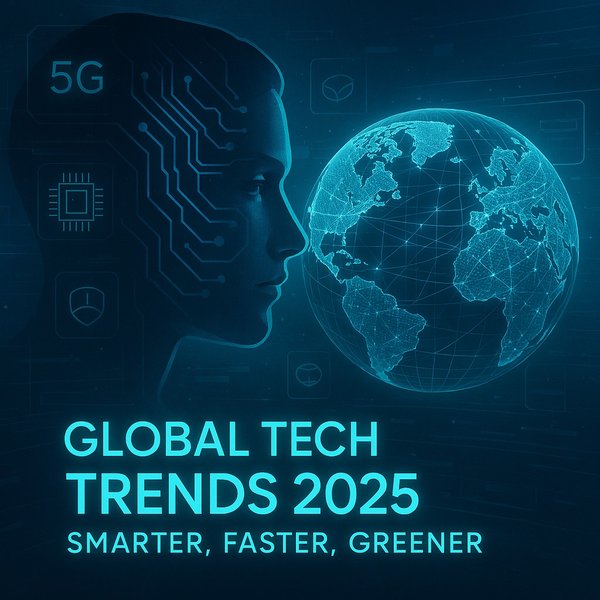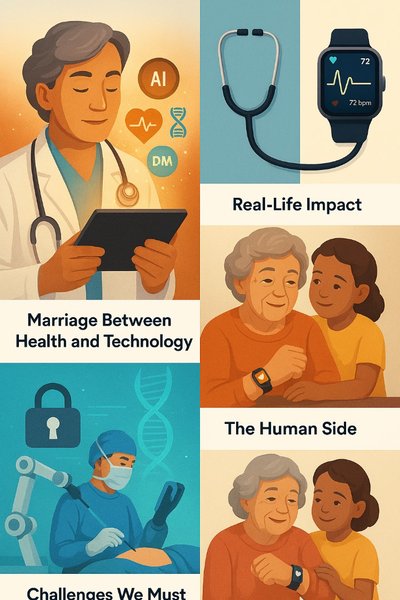🌐 Global Tech Trends in 2025: Innovations Shaping Every Industry
In a world where technology evolves faster than ever, 2025 is proving to be a defining year. Innovation is no longer just about gadgets—it’s about how deeply digital tools are reshaping how we live, work, learn, and create. From autonomous AI to immersive learning environments, smarter security, and sustainable infrastructure, this year is rewriting the rules across every industry. Below is a breakdown of the most powerful global tech trends of 2025, explained in simple terms so everyone—from creatives to entrepreneurs—can understand how they impact today’s world.
1. Agentic AI & Micro‑LLMs: AI That Works Like a Human Assistant
Agentic AI refers to systems that can make decisions, set goals, and complete tasks without needing to be told each step. It’s like having a digital assistant that doesn’t wait for commands—it predicts your needs and works ahead of time.
For example, agentic AI can:
-
Schedule your meetings based on your preferences.
-
Organize your work files before you even ask.
-
Analyze data and suggest the best actions for your business.
At the same time, micro-LLMs are smaller language models that work efficiently on mobile phones, laptops, or offline devices. They make AI accessible to people everywhere, even in low-internet areas.
Impact: Time-saving, cost-effective, and accessible automation.
2. Extended Reality (XR): Blending the Digital and Real Worlds
XR stands for Extended Reality, which includes AR (Augmented Reality), VR (Virtual Reality), and MR (Mixed Reality). In 2025, XR is making a big impact on education, retail, healthcare, and business.
-
Students can explore virtual classrooms, science labs, or ancient cities through VR.
-
Customers can “try on” clothes, furniture, or makeup with AR before buying.
-
Surgeons train using 3D virtual models of the human body.
Devices like smartphones and smart glasses now support XR experiences without needing expensive headsets.
Impact: More engaging learning, personalized shopping, and smarter training methods.
3. Edge Computing + 5G: Instant Tech Where It’s Needed
Edge computing allows data to be processed right where it’s created—on your phone, in your car, or on factory equipment. Combined with 5G (ultra-fast mobile internet), this allows apps and devices to respond instantly without waiting on slow cloud servers.
Real-world uses include:
-
Traffic lights that adapt in real-time based on congestion.
-
Remote farms using live sensor data to manage crops and water.
-
Drones performing inspections or deliveries without delays.
Impact: Speed, efficiency, and real-time solutions in every location.
4. Quantum Computing & Post‑Quantum Security: A New Era of Problem-Solving
Quantum computers use quantum mechanics to solve complex problems that classical computers can’t handle quickly. They’re not just faster—they work differently, and they’re unlocking new possibilities.
Quantum systems are helping:
-
Chemists design better medicines.
-
Engineers discover stronger materials.
-
Companies optimize massive supply chains.
But quantum computers also threaten today’s security systems. That’s why “post-quantum security” is a new standard in digital protection—built to survive the power of quantum attacks.
Impact: Massive computing power with stronger, future-proof encryption.
5. AI-Driven Cybersecurity & Zero Trust: Smarter, Adaptive Protection
Cyberattacks are getting smarter. Hackers now use AI to create fake voices, trick systems, or breach networks faster than humans can stop them. In response, cybersecurity is becoming AI-powered too.
Modern security tools now:
-
Detect strange user behavior automatically.
-
Stop attacks before damage is done.
-
Adapt and improve with every new threat.
Zero Trust Architecture means every user, device, and connection is verified at every point—no assumptions, no shortcuts.
Impact: More secure systems, safer data, and quicker threat response.
6. Green Tech & Sustainable Infrastructure: Tech Without the Carbon Cost
With more devices, data centers, and AI tools comes more energy consumption. In 2025, the push for sustainable innovation is stronger than ever.
Examples include:
-
Data centers powered by solar or wind energy.
-
Recycled computer parts and devices built for energy efficiency.
-
AI designed to use less electricity while performing faster.
Sustainable tech is now a business advantage, not just an environmental concern.
Impact: Cleaner growth, lower costs, and eco‑friendly innovation.
7. All in One: The Power of Convergence
Each of these technologies is powerful on its own—but when they come together, they create something even greater. Imagine this:
-
A mobile XR app running on a micro‑LLM, powered by edge computing and secured by quantum-safe encryption.
-
A city using AI and 5G to manage traffic, air quality, electricity, and emergencies in real-time.
-
A remote student in Africa learning physics through XR, powered by solar, with AI guiding their progress offline.
This is not far away—it’s happening now, all over the world.
🚀 Final Insight
Technology in 2025 is not just advancing—it’s merging into smarter, faster, greener systems that benefit everyone. Whether you’re a startup founder, content creator, policy maker, or student, understanding these trends helps you stay ahead and stay relevant.
The world is no longer waiting for the future.
The future is already adjusting to us.
💬 Join the Conversation
Which of these innovations do you find most exciting or useful in your field?
Are you already using any of them in your daily life or work?
Let’s hear your thoughts in the comments.




Comments (0)
Leave a Comment
No comments yet. Be the first to comment!